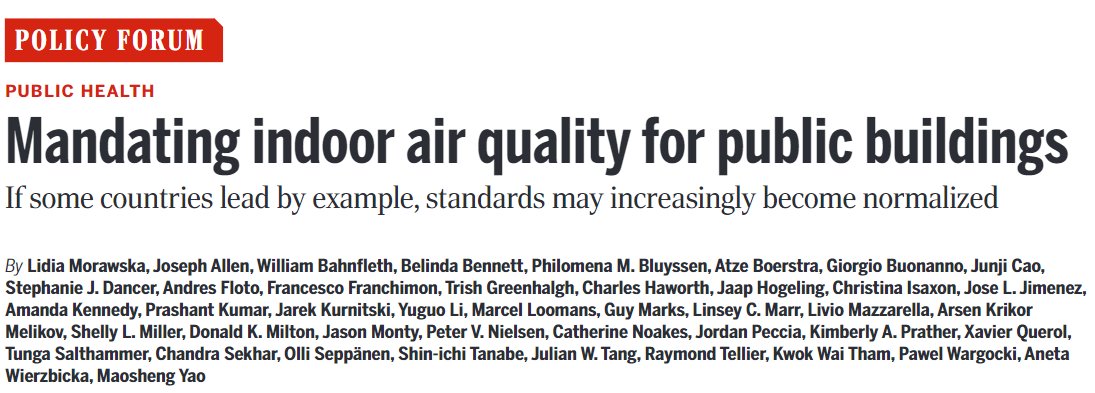1/ TEN SCIENTIFIC REASONS IN SUPPORT OF AIRBORNE TRANSMISSION OF SARS-CoV-2
Peer-reviewed publication in @TheLancet
An honor to have collaborated in multidisciplinary team across medicine, infectious diseases, epidemiology, aerosol science, sociology
thelancet.com/journals/lance…
Peer-reviewed publication in @TheLancet
An honor to have collaborated in multidisciplinary team across medicine, infectious diseases, epidemiology, aerosol science, sociology
thelancet.com/journals/lance…
2/ The authors are:
- @trishgreenhalgh, Prof. of Medicine at Oxford Univ., pioneer of evidence-based medicine (EBM)
- @DFisman, Prof. at Univ. of Toronto, epidemiologist
- @chipatucsd, Prof. of Medicine at UC-San Diego, Chief Editor of journal "Clinical Infectious Diseases"
- @trishgreenhalgh, Prof. of Medicine at Oxford Univ., pioneer of evidence-based medicine (EBM)
- @DFisman, Prof. at Univ. of Toronto, epidemiologist
- @chipatucsd, Prof. of Medicine at UC-San Diego, Chief Editor of journal "Clinical Infectious Diseases"
3/ The rest of the authors:
- @kprather, Prof. UC-San Diego, member of US National Academies of Science and of Engineering, aerosol scientist
- @zeynep, Prof. Univ. of North Carolina, sociologist
- Yours truly, Prof. Univ. of Colorado, Highly Cited Scientist, aerosol scientist
- @kprather, Prof. UC-San Diego, member of US National Academies of Science and of Engineering, aerosol scientist
- @zeynep, Prof. Univ. of North Carolina, sociologist
- Yours truly, Prof. Univ. of Colorado, Highly Cited Scientist, aerosol scientist
4/ We review ten different lines of evidence that support that SARS-CoV-2 is predominately airborne
I will review the the lines in this thread, with links to key references, and some additional detail to make it more understandable.
I will review the the lines in this thread, with links to key references, and some additional detail to make it more understandable.
5/ FIRST: lots of superspreading events, & the ones that have been studied in detail are best explained by airborne transmission
To our knowledge NOT a single peer-reviewed pub. of an outbreak reports w/ certainty likely droplet or surface transmission being major
To our knowledge NOT a single peer-reviewed pub. of an outbreak reports w/ certainty likely droplet or surface transmission being major
6/ An example is the Skagit Choir case that we investigated (led by @ShellyMBoulder, paper here, read the Supp. Info. for the real details: doi.org/10.1111/ina.12…), that I summarized in this thread:
https://twitter.com/jljcolorado/status/1306450428867964930
7/ Some people argue that superspreading events are interesting but minor overall. That is not correct. Superspreading plays a major part on pandemic spread, and controlling SSE is key to control the pandemic, as @nature summarizes here:
nature.com/articles/d4158…
nature.com/articles/d4158…
8/ SECOND LINE OF EVIDENCE: growing number of cases of long distance transmission. e.g. in quarantine hotels in Australia and New Zealand:
wwwnc.cdc.gov/eid/article/27…
wwwnc.cdc.gov/eid/article/27…
9/ Another recently-published case in which an infected person transmitted to several people who were 15 meters BEHIND. Genome sequencing shows that it was the same virus. Video shows that there was no close contact.
wwwnc.cdc.gov/eid/article/27…
wwwnc.cdc.gov/eid/article/27…
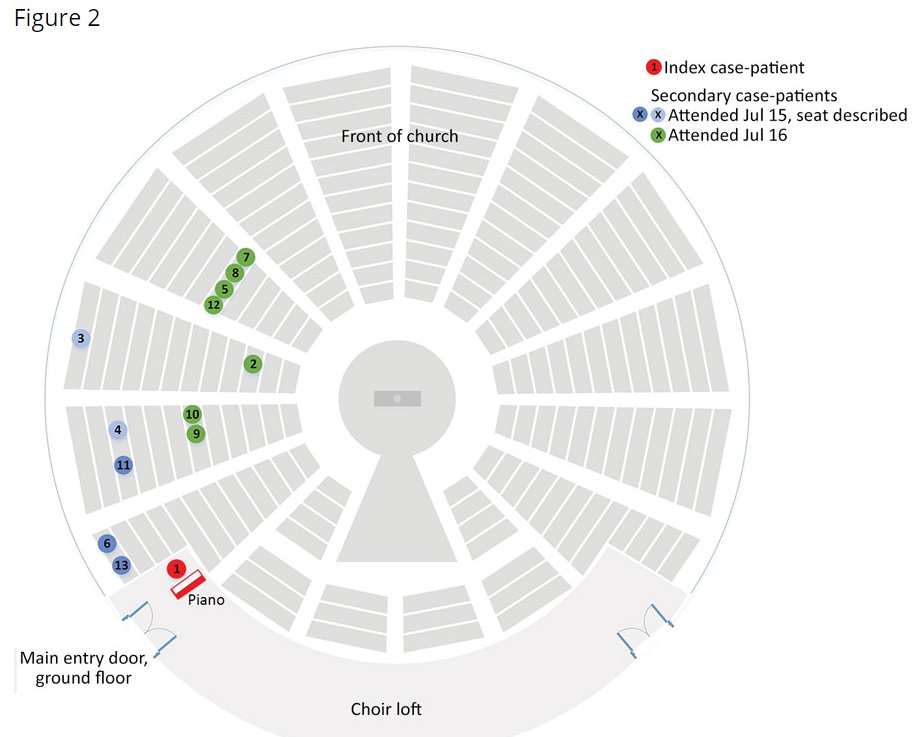
10/ Why are most of the long-distance transmission cases being identified in the quarantine hotels in Australia & New Zealand?
Because the lack of community cases makes it much more certain that transmission happened there. (Can't do in US)
Plus there is video surveillance etc
Because the lack of community cases makes it much more certain that transmission happened there. (Can't do in US)
Plus there is video surveillance etc
11/ Similarly, airborne transmission of smallpox was debated for centuries, but could only be definitely proven in the complete absence of community transmission
Pakistani electrician arrived in Germany, where there were no cases. Obvious long distance T
academic.oup.com/aje/article/93…
Pakistani electrician arrived in Germany, where there were no cases. Obvious long distance T
academic.oup.com/aje/article/93…

12/ THIRD LINE OF EVIDENCE: people w/o symptoms transmit 30-59% of the cases.
They don't cough or sneeze, so they produce very few large droplets. But they go around with their lives and produce lots of aerosols speaking etc.
jamanetwork.com/journals/jaman…
They don't cough or sneeze, so they produce very few large droplets. But they go around with their lives and produce lots of aerosols speaking etc.
jamanetwork.com/journals/jaman…
13/ FOURTH LINE OF EV.: transmission is 20 times more efficient indoors than outdoors.
Same gravity indoors and outdoors, large droplets do the same in either (can't explain difference)
Huge aerosol dilution outdoors vs. trapping indoors can explain it
academic.oup.com/jid/article/22…
Same gravity indoors and outdoors, large droplets do the same in either (can't explain difference)
Huge aerosol dilution outdoors vs. trapping indoors can explain it
academic.oup.com/jid/article/22…
14/ FOURTH AND A HALF: ventilation of indoor spaces reduces transmission significantly. This is accepted by e.g. @WHO, which recently published a Roadmap to reduce transmission w/ ventilation.
Ventilation impacts airborne, NOT droplets or surfaces
who.int/publications/i…
Ventilation impacts airborne, NOT droplets or surfaces
who.int/publications/i…
15/ I have yet to hear an attempt at explaining why (f large droplets dominate transmission as @WHO and @CDCgov say) there is such a large indoor / outdoor difference in transmission, or such an impact of ventilation.
Strongly implies airborne is PREDOMINANT mode of transmission
Strongly implies airborne is PREDOMINANT mode of transmission
16/ FIFTH: studies have demonstrated (e.g. at Harvard Univ. hospital -- BWH) that health care workers were infected despite contact and droplet protections and eye protection. Genomic match
Surgical masks protect well, but not perfectly against aerosols
acpjournals.org/doi/full/10.73…
Surgical masks protect well, but not perfectly against aerosols
acpjournals.org/doi/full/10.73…

17/ SIXTH: viable SARS-CoV-2 virus has been detected in the air from two hospitals and a car where infected person was present.
And this has NEVER been achieved for measles or tuberculosis, two accepted airborne diseases.
ijidonline.com/article/S1201-…
And this has NEVER been achieved for measles or tuberculosis, two accepted airborne diseases.
ijidonline.com/article/S1201-…
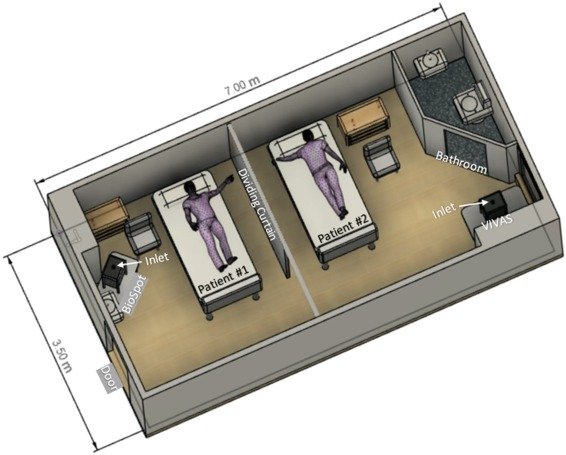
18/ SEVENTH LINE OF EVIDENCE: virus material has been detected via PCR on HVAC ducts and filters of a hospital. It could only have gotten there if it was floating in the air as an aerosol.
nature.com/articles/s4159…
nature.com/articles/s4159…

19/ EIGHTH LINE OF EVIDENCE: airborne transmission has been demonstrated with animal models such as ferrets and hamsters.
nature.com/articles/s4146…
nature.com/articles/s4146…
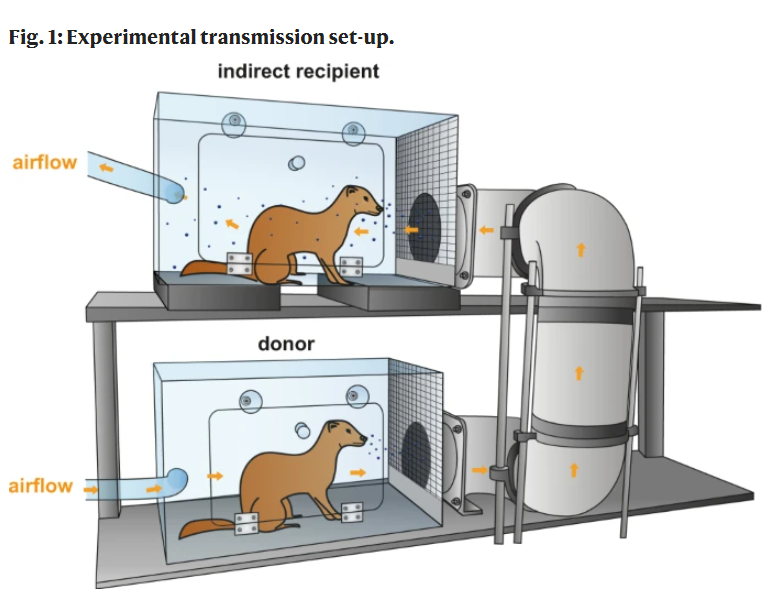
20/ Of note is that demonstration of airborne transmission with an animal model (guinea pigs) by Richard Riley and Williams Wells in 1961 is what led to the acceptance that tuberculosis was transmitted through the air, after 5 decades of denial.
atsjournals.org/doi/10.1164/ar…
atsjournals.org/doi/10.1164/ar…
21/ NINTH: no published studies with strong evidence that contradicts airborne transmission.
There are cases of shared air w/o transmission, but they are easily explained by very large variation in virus emission among people & in time, + ventilation
ehp.niehs.nih.gov/doi/10.1289/EH…
There are cases of shared air w/o transmission, but they are easily explained by very large variation in virus emission among people & in time, + ventilation
ehp.niehs.nih.gov/doi/10.1289/EH…
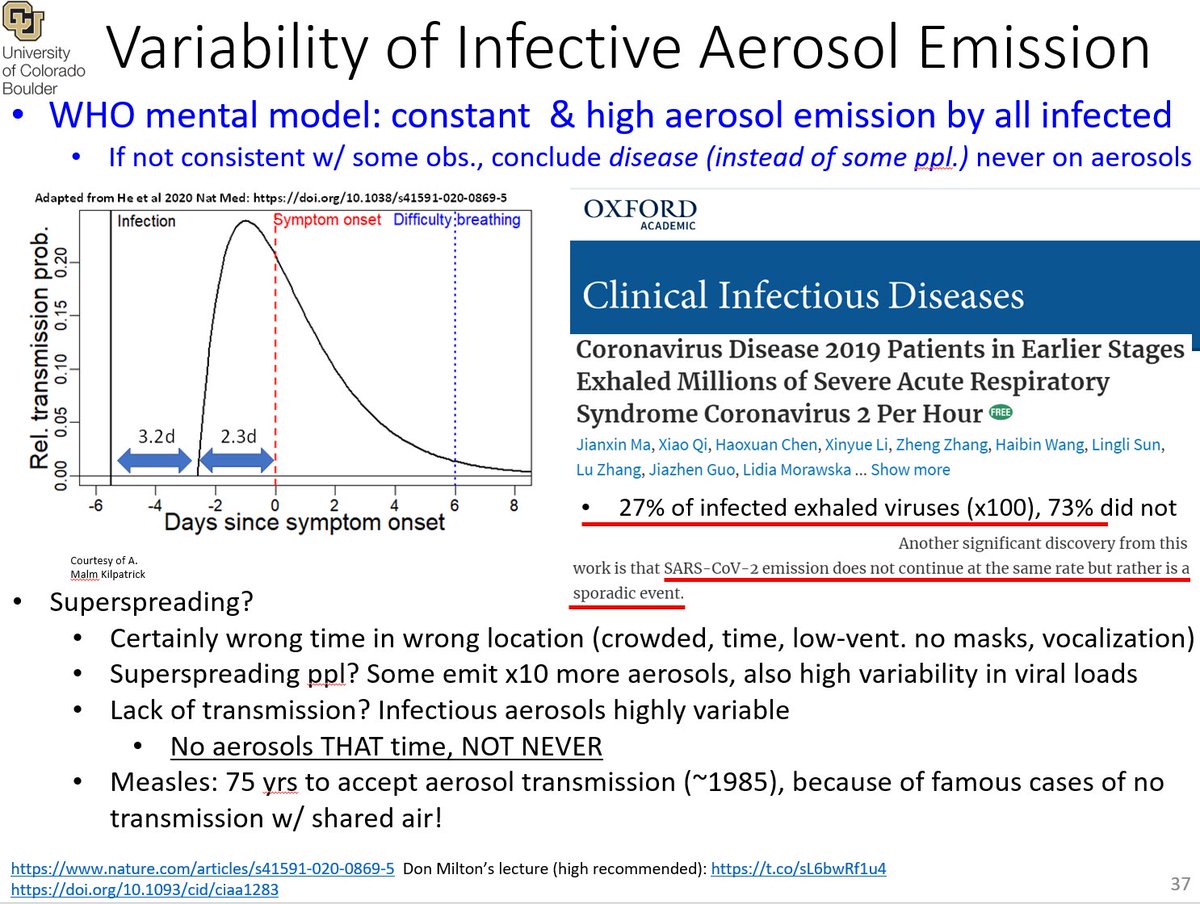
22/ Some people argue that R0 would be higher if SARS-CoV-2 was airborne
But tuberculosis is only airborne, and is less contagious than COVID
And R0 is very skewed, many don't transmit, a few transmit a lot (consistent w/ aerosols w/ variable emission): wellcomeopenresearch.org/articles/5-67
But tuberculosis is only airborne, and is less contagious than COVID
And R0 is very skewed, many don't transmit, a few transmit a lot (consistent w/ aerosols w/ variable emission): wellcomeopenresearch.org/articles/5-67
23/ We dispel the myth about R0, as well as other commonly-held myths about airborne transmission in this article in the Journal of Hospital Infection, led by prominent virologist Julian Tang:
sciencedirect.com/science/articl…
sciencedirect.com/science/articl…

24/ TENTH: there is limited evidence to support that another route of transmission is dominant (or I add, even important).
Surfaces: @CDCgov and multiple literature studies have been clear that surface transmission of SARS-CoV-2 is rare:
cdc.gov/coronavirus/20…
Surfaces: @CDCgov and multiple literature studies have been clear that surface transmission of SARS-CoV-2 is rare:
cdc.gov/coronavirus/20…
25/ Here the Editors of @nature were practically yelling (on 2-Feb) to @WHO and @CDCgov to say clearly that surfaces transmit little, and that surface disinfection is not important, and efforts should focus on the air.
nature.com/articles/d4158…
nature.com/articles/d4158…
26/ There is also no clear evidence of large droplet transmission.
Ease of transmission in close proximity has been attributed (erroneously, see next) since 1910 to large droplets, which fall to the ground in 1-2 m
@WHO video illustrates it perfectly:
Ease of transmission in close proximity has been attributed (erroneously, see next) since 1910 to large droplets, which fall to the ground in 1-2 m
@WHO video illustrates it perfectly:
https://twitter.com/WHO/status/1244258441880797184
27/ But this is an error! Modern science shows that if a disease is transmitted easily in close proximity while talking, and social distance reduces transmission, that is explained mainly by short-range airborne transmission, and NOT by droplets.
sciencedirect.com/science/articl…
sciencedirect.com/science/articl…

28/ Ease of transmission in close proximity (along with cases of lack of transmission in shared air, see tweet #21) was used for 7 decades to declare measles a droplet / fomite disease, and to deny its airborne character.
pediatrics.aappublications.org/content/75/4/6…
pediatrics.aappublications.org/content/75/4/6…

29/ In fact, droplet transmission has NEVER been demonstrated directly for ANY disease in entire history of medicine
(From a review of the literature by Prof. Yuguo Li et al. in this paper: sciencedirect.com/science/articl…. If you have a paper that proves otherwise, pls send it my way)
(From a review of the literature by Prof. Yuguo Li et al. in this paper: sciencedirect.com/science/articl…. If you have a paper that proves otherwise, pls send it my way)

30/ So how did ease of infection in close proximity come of be interpreted as PROOF of droplet transmission and evidence against airborne transmission?
Charles Chapin was a prominent American Public Health researcher, 1927 president of American PH Ass.
en.wikipedia.org/wiki/Charles_V…
Charles Chapin was a prominent American Public Health researcher, 1927 president of American PH Ass.
en.wikipedia.org/wiki/Charles_V…
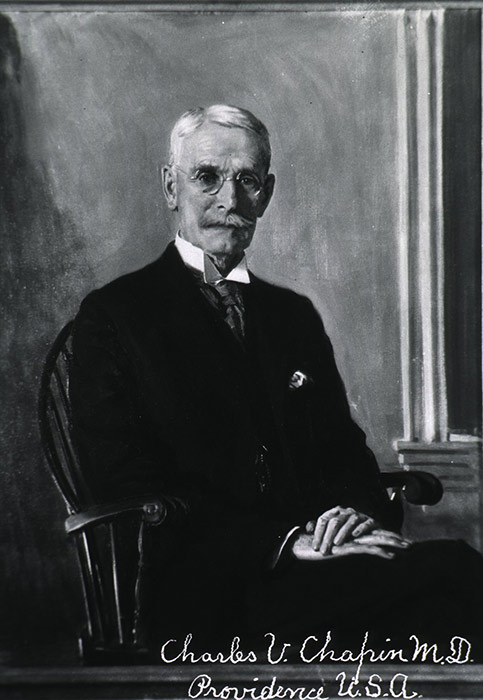
31/ In his 1910 seminar book, "The Sources and Modes of Infection" (archive.org/details/source…), Chapin misinterpreted the earlier measurements of Flugge in 1890s.
Fluggle waited 5 hrs for aerosols to settle on plates. But got distorted into "sprayborne droplets" by Chapin.
Fluggle waited 5 hrs for aerosols to settle on plates. But got distorted into "sprayborne droplets" by Chapin.
32/ Chapin through contact infection was most important. But observed:
"it is impossible, as I know from experience, to teach people to avoid contact infection while they are firmly convinced that the air is the chief vehicle of infection"
Airborne trans. was getting in his way
"it is impossible, as I know from experience, to teach people to avoid contact infection while they are firmly convinced that the air is the chief vehicle of infection"
Airborne trans. was getting in his way

33/ He admits that there is no clear evidence against airborne transmission, as aerosol measurements were not developed yet.
Still proceeds to "discard airborne infection.":
"It will be a great relief to most persons to be freed from the specter of infected air"
Still proceeds to "discard airborne infection.":
"It will be a great relief to most persons to be freed from the specter of infected air"
34/ Unfortunately Chapin is too successful. And even though there was not evidence to show that close contact transmission was explained by Chapin's "sprayborne droplets", this became a tradition and a dogma.
#DropletDogma
#DropletDogma
35/ Airborne trans. denied for decades. Wells (en.wikipedia.org/wiki/William_F…), Riley fight back.
First director of CDC (A. Langmuir) makes fun of Wells in 1950 for thinking that ANY natural disease can be airborne
We have just submitted a paper on this history, preprint out next wk
First director of CDC (A. Langmuir) makes fun of Wells in 1950 for thinking that ANY natural disease can be airborne
We have just submitted a paper on this history, preprint out next wk
36/ Eventually the evidence becomes undeniable for a few diseases: TB in 1961 (short story: atsjournals.org/doi/full/10.11…), and later for measles and chickenpox.
Note that in 1985 still most public health authorities described measles as droplet/fomite (pediatrics.aappublications.org/content/75/4/6…)
Note that in 1985 still most public health authorities described measles as droplet/fomite (pediatrics.aappublications.org/content/75/4/6…)
37/ Incidentally, measles and chickenpox were accepted as airborne with A LOT less evidence than we have now for COVID-19.
(From:
(From:
https://twitter.com/JenniferKShea/status/1373840694176010240)
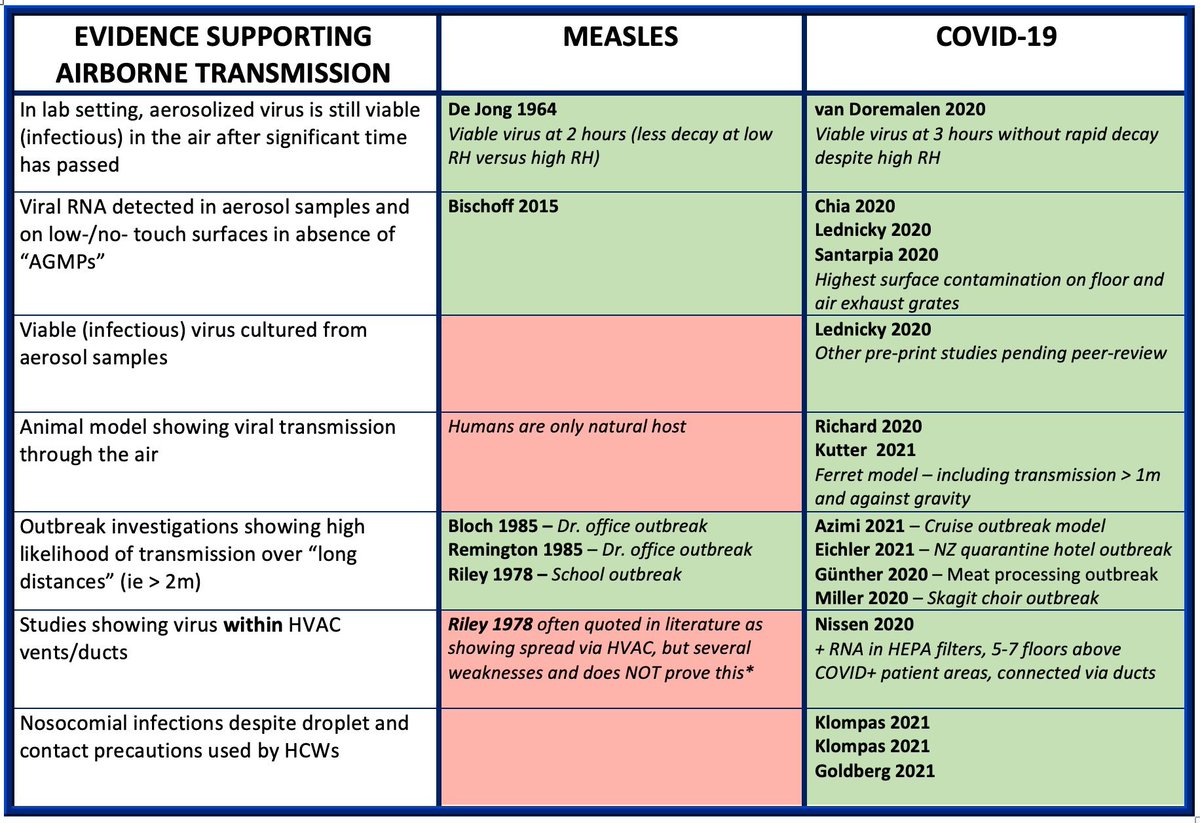
38/ Airborne transmission is considered very very difficult, little attention devoted to it.
So huge errors (the size of Godzilla) creep into the description of droplets and aerosols in medical textbooks, such as 5 um being the separation (it is 100)
So huge errors (the size of Godzilla) creep into the description of droplets and aerosols in medical textbooks, such as 5 um being the separation (it is 100)
https://twitter.com/jljcolorado/status/1295518786951319552
39/ We already knew in 1934 (from Wells' work at Harvard academic.oup.com/aje/article-ab…) that droplets vs. aerosols boundary was at 100 microns.
Reaffirmed by @theNASEM and @ScienceMagazine: science.sciencemag.org/content/370/65…
Reaffirmed by @theNASEM and @ScienceMagazine: science.sciencemag.org/content/370/65…
40/ Back to @TheLancet: "There is consistent, strong evidence that SARS-CoV-2 spreads by airborne trans. Although other routes can contribute, we believe that the airborne route is likely to b dominant. The public health community should act accordingly and without further delay" 
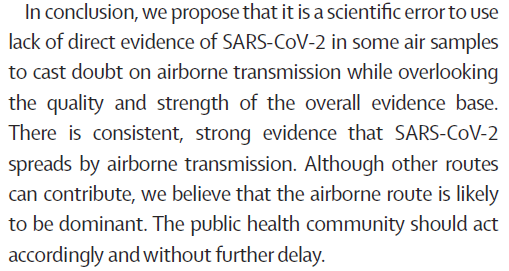
41/ If I missed something, if you think there is an error, if you think there is evidence we are not considering, send it my way.
If you know of a paper that reviews as much evidence and explains why it is really droplets, definitely send it my way (haven't seen any).
If you know of a paper that reviews as much evidence and explains why it is really droplets, definitely send it my way (haven't seen any).
Typo: messed up Kim Prather's handle in tweet #3, it is @kprather88
44/ OK, so it's airborne, how do we protect ourselves better?
See our scientists FAQs at Tinyurl.com/faqs-aerosol
See our scientists FAQs at Tinyurl.com/faqs-aerosol
45/ Reaction from higher ups in large Public Health agency (confidentially thru colleague)
They still don't think it's airborne, based on these considerations:
- there are still not enough good masks
- ventilation changes would be expensive
Not a joke, this is what I was told
They still don't think it's airborne, based on these considerations:
- there are still not enough good masks
- ventilation changes would be expensive
Not a joke, this is what I was told
46/ So far the @TheLancet piece seems to be having a high impact, thanks to everyone for bringing attention to it.
altmetric.com/details/103982…
altmetric.com/details/103982…

48/ And this is an 11th reason why SARS-COV-2 airborne transmission is dominant: likelihood of anisotropic infection (aerosols infect at much lower doses than droplets). It had not been published when we wrote @TheLancet publication.
https://twitter.com/jljcolorado/status/1387554983890067459
Our @TheLancet paper laying out evidence that airborne transmission is predominant for SARS-CoV-2 keeps having a huge impact. Altmetric score above 17000 (altmetric.com/details/103982…)
If you have not read it yet, it is short, easy to read, and free online:
thelancet.com/journals/lance…
If you have not read it yet, it is short, easy to read, and free online:
thelancet.com/journals/lance…

• • •
Missing some Tweet in this thread? You can try to
force a refresh




